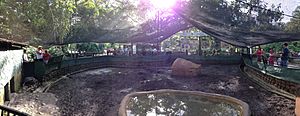Giant Armadillo facts for kids
Quick facts for kids Armadillo raksasa |
|
|---|---|
 |
|
| Conservation status | |
| Scientific classification | |
| Kingdom: | |
| Phylum: | |
| Class: | |
| Order: | |
| Family: | |
| Subfamily: |
Tolypeutinae
|
| Genus: |
Priodontes
|
| Species: |
P. maximus
|
| Binomial name | |
| Priodontes maximus (Kerr, 1792)
|
|
The Giant Armadillo (Priodontes maximus), colloquially Tatou, Ocarro, Tatu-canastra or Tatú Carreta, is the largest living species of armadillo. It was once found widely throughout the tropical forests of eastern South America and now ranges throughout varied habitat as far south as northern Argentina.
Description
The giant armadillo is the largest living species of armadillo, with 11 to 13 hinged bands protecting the body and a further three or four on the neck. Its body is dark brown in color, with a lighter, yellowish band running along the sides, and a pale, yellow-white head. These armadillos have around 80 to 100 teeth, which is more than any other terrestrial mammal. The teeth are all similar in appearance, being reduced premolars and molars, grow constantly throughout life, and lack enamel. They also possess extremely long front claws, including a sickle-shaped third claw, which are proportionately the largest of any living mammal. The tail is covered in small rounded scales and does not have the heavy bony scutes that cover the upper body and top of the head. The animal is almost entirely hairless, with just a few beige colored hairs protruding between the scutes.
Giant armadillos typically weigh around 18.7–32.5 kg (41–72 lb) when fully grown, however a 54 kg (119 lb) specimen has been weighed in the wild and captive specimens have been weighed up to 80 kg (180 lb). The typical length of the species is 75–100 cm (30–39 in), with the tail adding another 50 cm (20 in).
Distribution and habitat
Giant armadillos are found throughout much of northern South America east of the Andes, except for eastern Brazil and Paraguay. In the south, they reach the northernmost provinces of Argentina, including Salta, Formosa, Chaco, and Santiago del Estero. There are no recognised geographic subspecies. They primarily inhabit open habitats, with cerrado grasslands covering about 25% of their range, but they can also be found in lowland forests.
Biology and behavior

Giant armadillos are solitary and nocturnal, spending the day in burrows. They also burrow to escape predators, being unable to completely roll into a protective ball. Compared with those of other armadillos, their burrows are unusually large, with entrances averaging 43 cm (17 in) wide, and typically opening to the west.
Giant armadillos use their large front claws to dig for prey and rip open termite mounds. The diet is mainly composed of termites, although ants, worms, spiders and other invertebrates are also eaten. Little is currently known about this species' reproductive biology, and no juveniles have ever been discovered in the field. The average sleep time of a captive giant armadillo is said to be 18.1 hours.
Armadillos have not been extensively studied in the wild; therefore, little is known about their natural ecology and behavior. In the only long term study on the species, that started in 2003 in the Peruvian Amazon, dozens of other species of mammals, reptiles and birds were found using the giant armadillos' burrows on the same day, including the rare short-eared dog (Atelocynus microtis). Because of this, the species is considered a habitat engineer, and the local extinction of Priodontes may have cascading effects in the mammalian community by impoverishing fossorial habitat.
Female giant armadillos have two teats and are thought to normally give birth to only a single young per year. Little is known with certainty about their life history, although it is thought that the young are weaned by about seven to eight months of age, and that the mother periodically seals up the entrance to burrows containing younger offspring, presumably to protect them from predators. Although they have never bred in captivity, a wild-born giant armadillo at San Antonio Zoo was estimated to have been around sixteen years old when it died.
Images for kids
-
The skeleton with skeleton of six-banded armadillo (bottom right) at the Cambridge University Museum of Zoology in England
See also
 In Spanish: Armadillo gigante para niños
In Spanish: Armadillo gigante para niños



